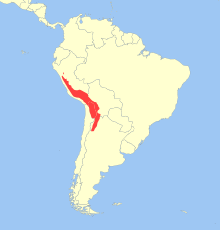Taruca
| Taruca | |
|---|---|
 | |
| Scientific classification | |
| Kingdom: | Animalia |
| Phylum: | Chordata |
| Clade: | Synapsida |
| Class: | Mammalia |
| Order: | Artiodactyla |
| Family: | Cervidae |
| Subfamily: | Capreolinae |
| Genus: | Hippocamelus |
| Species: | H. antisensis |
| Binomial name | |
| Hippocamelus antisensis d'Orbigny, 1834 | |
 | |
| Geographic range | |
The taruca (Hippocamelus antisensis), or north Andean deer, is a species of deer native to South America.
Description
Tarucas are medium-sized deer with heavy bodies. They measure 128 to 146 cm (50 to 57 in) from head to rump, with a 11 to 13 cm (4.3 to 5.1 in) tail, and stand 69 to 80 cm (27 to 31 in) tall at the shoulder. Adults weigh between 69 and 80 kg (152 and 176 lb). As with most deer, males are significantly larger than females.[2]
The hair is sandy brown over most of the body, with white patches on the underside of the head, neck, tail, and genital region, and on the inner surface of the fore-legs. While females often have a dark brown area on the forehead, facial markings are much clearer in the males. The exact patterns vary between different males, but in general there is a black behind the nose, and a black Y or V pattern over the forehead and snout.[2]
Male tarucas have antlers, typically measuring 27 cm (11 in) in length once fully grown. Unlike all other South American deer, except for the closely related huemul, the antlers consist of just two tines, branching close to the base, and with the posterior tine being the larger. Males also possess canine teeth in their upper jaw, which females usually, but not always, lack.[2]
Distribution and habitat
Tarucas are found only in the Andes mountains, from central Peru, through Bolivia and extreme north-eastern Chile, and into northern Argentina. In Argentina, they are found between 2,000 and 3,000 m (6,600 and 9,800 ft), but the elevation of their preferred habitat gradually rises as they approach the equator, until it reaches 3,500 to 5,000 m (11,500 to 16,400 ft) in Peru. Within this region, they are found in grasslands marked by occasional shrubs and rocky outcrops, typically close to water.[1] There are no recognised subspecies.
Diet and behaviour
Despite living in grasslands, tarucas feed mainly on the local bushes, shrubs, and herbs for much of the year, although they supplement this diet with grasses during the rainy season. Plants commonly eaten include dwarf gentian, ragworts, lupins, senna, valerian, and clubmosses. Tarucas may also feed on agricultural crops, such as alfalfa, barley, and potato plants.[2]
Tarucas are gregarious, but do not live in stable herds, with individuals moving between groups of up to thirty members each over the course of a few days. Their populations are scattered, due to their need for relatively specialised habitats, with population densities as low as 0.15/km2 (0.39/sq mi), even away from human habitation. Individual groups are typically led by the females.[3] During the breeding season, males may compete with on another, displaying threatening behaviour by raising their forelegs one at a time and pointing their antlers towards one another.[3]
Reproduction
The rut lasts from May to July, during which time the deer segregate into smaller groups with a single adult male. Males drop their antlers immediately after the breeding season finishes, in September, with the new pair beginning to grow in December, and losing the velvet by February. Pregnancy lasts for 240 days, so that the single fawn is born between January and March, coinciding with the rainy season. Twins have been observed in captivity, but are rare. The mother leaves the group in order to give birth, and keeps the fawn hidden behind rocky outcrops for the first month of life.[2]
References
- 1 2 Barrio, J. & Ferreyra, N. (2008). "Hippocamelus antisensis". IUCN Red List of Threatened Species. Version 2008. International Union for Conservation of Nature. Retrieved 8 June 2007.
- 1 2 3 4 5 Barrio, J. (2013). "Hippocamelus antisensis (Artiodactyla: Cervidae)". Mammalian Species. 45 (901): 49–59. doi:10.1644/901.1.
- 1 2 Roe, N. & Rees, W. (1976). "Preliminary observations of the taruca (Hippocamelus antisensis: Cervidae) in southern Peru". Journal of Mammalogy. 57 (4): 722–730. doi:10.2307/1379442. JSTOR 1379442.
